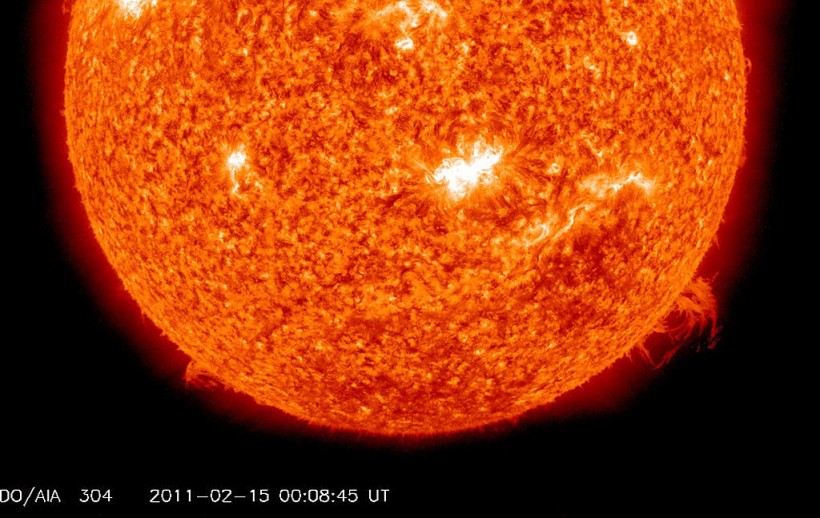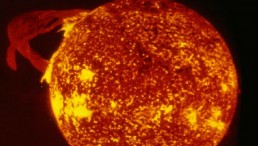Several studies show that a powerful solar flare might be strong enough to kill astronauts in a spaceship with inadequate shielding and could even harm airplane passengers.
Unless astronauts' vessel is composed of the correct materials, the crew of a future expedition to Mars may be in danger.
Solar flares send high-energy protons soaring across the solar system. The resulting radiation can be dangerous to astronauts' health.
For the past four decades, scientists have only been able to detect the radiation from solar outbursts directly.
Because the sun undoubtedly generates flares larger than any witnessed during this time, they used to simply aggregate the intensities of two known occurrences, or mix the features unique to each, to estimate the worst-case event.

In a screen grab taken from a handout timelapse sequence provided by NASA / SDO, a solar spot in the center of the Sun is captured from which the first X-class flare was emitted in four years on February 14, 2011.
NOAA Lists Solar Storm Consequences
Though solar storms may be dangerous, NOAA issued a balanced list of "possible consequences" from this solar storm, which isn't very large.
Experts noted an increase in the solar radiation spectrum's energetic section. The data further suggests that higher biological risk to astronauts or passengers and crew in high latitude, high altitude trips.
On every trip, passengers are exposed to small levels of cosmic radiation from space. However, high-altitude flights distant from the equator are at greater danger during a solar storm because the magnetic field will drive radiation toward the poles.
The brief study concluded that this information should be considered in conjunction with the present Solar Radiation Storm circumstances when analyzing the overall effect.
Man-made gear in space may also be in jeopardy.
Weatherboy, citing SWPC's bulletin, said: "Energetic particles may represent an increased risk to all satellite systems susceptible to single event effects."
ALSO READ: Earth Should Brace For Another Geomagnetic Storm This Month, NOAA - SWPC Warns
Satellites could be at more risk in the future, according to CNBC, as the Sun moves closer to a period where solar flares will be more prevalent.
NOAA and Nasa disagree on when the newest solar storm will impact Earth, with an 18-hour difference in their projections.
Solar Flares Might Kill Unprotected Astronauts
In the upper atmosphere, nitrates and beryllium-10 were created by the Carrington flare's radiation. These were encased in Greenlandic ice and can now be measured in ice cores by scientists.
The amount of nitrates indicates that Earth's atmosphere was bombarded with approximately 20 billion high-energy protons per square centimetre, more than any other event in the past 500 years. The beryllium also reveals that the energy spectrum of these protons was similar to that of a flare recorded in August 1972.
Based on evidence left behind in Greenland's ice nearly 150 years ago, Lawrence Townsend and colleagues from the University of Tennessee in Knoxville, US, calculated the radiation effects of the most powerful solar flare ever recorded.
This information was used by Townsend's team to calculate the radiation doses that astronauts would receive from a Carrington-type flare at various shielding levels. They discovered that astronauts shielded by just a few centimetres of aluminum - the typical spacecraft shielding - would be exposed to a dose that could cause acute radiation sickness and even death.
According to Townsend, astronauts on the International Space Station should be unconcerned. Even in the worst-case scenario, parts of the station have enough shielding. The Sun's activity is closely monitored, so the crew should have several hours to hide if a massive flare erupts.
However, it could have ramifications for long-duration interplanetary crewed missions. For a spacecraft to Mars, conventional aluminum may not be the best construction material.
"Aluminium is not a good radiation shield," Townsend said per New Scientist. He added, "We are looking at alternative materials, such as polyethylene and carbon foams impregnated with hydrogen. A worst-case event would probably be survivable if you use some other material than aluminium."
RELATED ARTICLE: What Are The Weird Waves Inside the Sun That Defy Physics? Scientists Explain Mystery
Check out more news and information on Space in Science Times.














